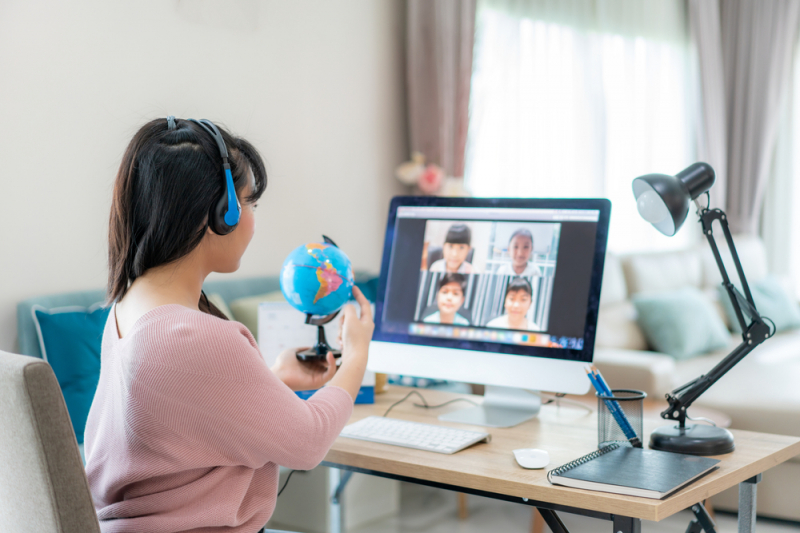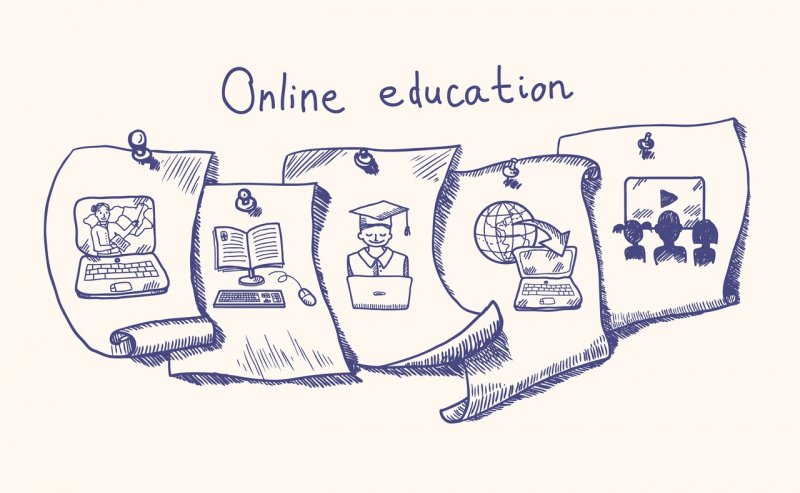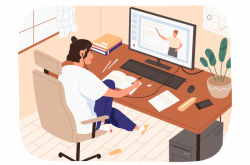Tackling the issues of distance learning
Distance learning is, no doubt, quick and convenient, but adopting this format comes with several technical challenges as well as communication issues between students and teachers. The online nature of the classes minimizes the opportunity for social connections and robs the teacher of their importance as the leader and mentor. Capturing the students’ attention becomes much more difficult: energy, charisma, or body language are no longer enough. At the same time, it is almost impossible to supervise students and to make sure they are focused enough, as feedback is minimal or nearly non-existent.
However, as it always is with study or work groups – be they virtual or real –, feedback issues only come up at the start. The most difficult part is the beginning: that includes all matters of organization, disciplines, and communication, as well as technical issues. With practice comes an understanding of how to speak to students and present material to them.

A few pieces of advice for organizing online classes:
- don’t stretch out the introduction;
- make use of transitions between topics and summarize the material;
- use more examples and cases;
- add more tasks and interactivity;
- avoid off-topic questions and discussions;
- don’t ignore your students’ questions, but also don’t interrupt yourself by reacting to every comment;
- answer questions in batches after each information segment or at the end of the class;
- test the students’ comprehension after or during class with polls and tests;
- don’t overdo the amount of information you convey and tests you give.
Conflict management

Unfortunately, pranksters intruding on online classes have become all too common in recent times. The only surefire solution to the problem is to stop the class and start a new conference by sending invite links to the students.
To minimize the chances of an attack, follow the basic safety rules: protect your chatrooms with passwords, don’t share links where anyone can see them, and check your software settings to make sure that only the admin user can broadcast their screen or use other features (share files, draw, add backgrounds, send private messages).
But what do you do if the culprit is no random passer-by, but one of your students? First, figure out their intentions. If they’re simply trying to rile you up, express your feelings honestly and suggest they disconnect. Under no circumstances should you lose temper or blame the group; in that case, they’ll be likely to side against you. At the same time, don’t make excuses or blame yourself; the best way to handle any such situation is to reinforce your authority with a bit of humor or irony.
But sometimes, students have legitimate grievances or simply disagree with your stance on a subject. A conflict between the student and the teacher is still a form of communication, albeit a specific one. Disagreements are bound to emerge in the learning process, and arguments pave the way to their resolution; in this case, a result achieved through conflict will be much more important than its cause.
In an argument, conduct yourself well, don’t give in to emotions or manipulation, and try to really listen to the student’s complaints or requests. All this helps fix relations and resolve issues. Remember that any conflict is a growth point for both sides.
The hurdles of student-teacher relations

A study conducted among some 100 teachers at the Smolensk State University has shown that, from the point of view of teachers, optimal relations with students are primarily based on mutual respect and understanding (33%), interest towards the subject (23%), friendly atmosphere (20%), and academic performance (17%). Among the disruptors, on the other hand, are poor discipline, lack of attendance, irresponsibility, and manipulation and conflicts instigated by students. In the students’ opinions, the negative factors in maintaining pleasant relations with their teachers are bias and unfairness in grading, condescending treatment of students, lack of restraint and lashings-out, incompetence, negligence, and ineffective class structure.
To sum up, the key causes of conflicts are unfair grades affected by the students’ personal qualities, teachers’ sympathies (or lack thereof), dishonest attitude on both sides, and the hierarchical nature of these relations.

So what ways are there to improve your relations with students?
Here are the few key principles to help you:
- Tap into the students’ needs and motives – ask them questions and carefully process the answers to learn more about them and establish good feedback;
- Remain unbiased and fair: only assess the students’ actions and behavior, not their personal qualities. Don’t exercise power against them, don’t threaten them with authority, or force them – all these things will only trigger their defensive mechanisms and lead to conflict;
- Most importantly, be natural and don’t play the role of someone else. Whether you consider yourself a strict and demanding teacher or a kind and sympathetic one, don’t mold yourself into the opposite – the students wouldn’t understand and you’ll only feel out of your element.
Types of students and how to deal with them

In the process of communication, we interact with different kinds of people: with some, we instantly reach complete mutual understanding, with others, there’s no common ground to be found. An important goal for every teacher is to find the right approach for any student.
Tatiana Mishatkina, ethics teaching expert, has come up with an amusing student typology. These models are quite general, but should be helpful in reaching a better understanding of one’s students and finding the right individual approach.
The “positive conversationalist” is the most agreeable of them all. They are well-meaning, hardworking, sympathetic, and can become a sort of assistant in class. With any difficulty or conflict, don’t hesitate to call on them and use them as an example for other students.
The “nihilist” is impatient, crabby, provocative in conversation, disagreeable, and contrarian. When communicating with this student, it’s important to remain confident and project competence. At the same time, allow them to speak out and formulate their solution to the problem, thus ingratiating yourself with them and turning criticism into constructive conversation.
The “all-knowing” has an opinion on everything and a strong desire to make it known. This student doesn’t always disrupt class, but they often grab too much attention to the detriment of others. Students of this type must be reminded that they’re not alone in class. You can also boggle them with difficult questions.
The “blabbermouth” talks a lot, mostly off-topic, interrupts others, and derails the conversation. Always impose a time limit on their talks and bring them back to the subject if they start to get off track.
The “hesitant” student is unsure, afraid of coming off as ignorant, and thus reluctant to speak. They can be drawn into the conversation through simple questions; support them by positively acknowledging their contributions to the discussion.
The “unapproachable” is one of the most challenging types. They are contemptuous, reserved, and uninterested in the topic of the class. Grab their attention by asking what they disagree with and why, or what interests them.
The “busybody” asks too many questions, not all of them on topic. Redirect their questions to the other participants or provide short, concise answers. You can keep them busy for a while by giving them a clear, understandable task that wouldn’t cause too many follow-up questions.
Communication barriers

Talking to the students can be made difficult by the teacher’s own psychological problems – the so-called communication barriers. Most of them are related to the fear of public speaking and are typical of fledgling young teachers.
The fear of students barrier emerges when the teacher is seemingly well-versed in the subject, but the mere thought of communicating with and talking to students causes panic. This barrier can be worsened by negative past experiences. The solution to this issue is practice and repetition.
The fear of error barrier stems from the same issues. The teacher may be afraid to be late to class, to misspeak, to appear ignorant, not to go through all the material, etc. To fight this fear, you must understand that students are not enemies nor judges – they’re your assistants.
The negative narrative barrier may be formed indirectly through conversations with colleagues who have had issues with a certain group of students. Take your peers’ advice to mind, but come to class unbiased.
The lack of contact barrier presents itself in a teacher’s “autonomy” from the audience; instead, you must quickly and efficiently set up mutual communication with the students. This is the biggest issue in distance learning and it can only be solved through constant work on establishing feedback and talking to your students.
The limited communication barrier is caused by teachers only paying attention to the informative goals of communication while ignoring the social and other aspects. This makes students bored, uninterested, and thus less able to absorb information.
The mismatched narrative barrier: imagine you come into class with an interesting idea, project, or lecture and are met with indifference. Such a reaction can make the teacher angry, annoyed, or frustrated. It’s important to understand that the reason isn’t in you or in your material, but something else. Maybe the students are on a deadline, maybe they’ve got a project coming up, or maybe something just went wrong. Don’t hesitate to talk to them and get down to the reasons for their indifference.





